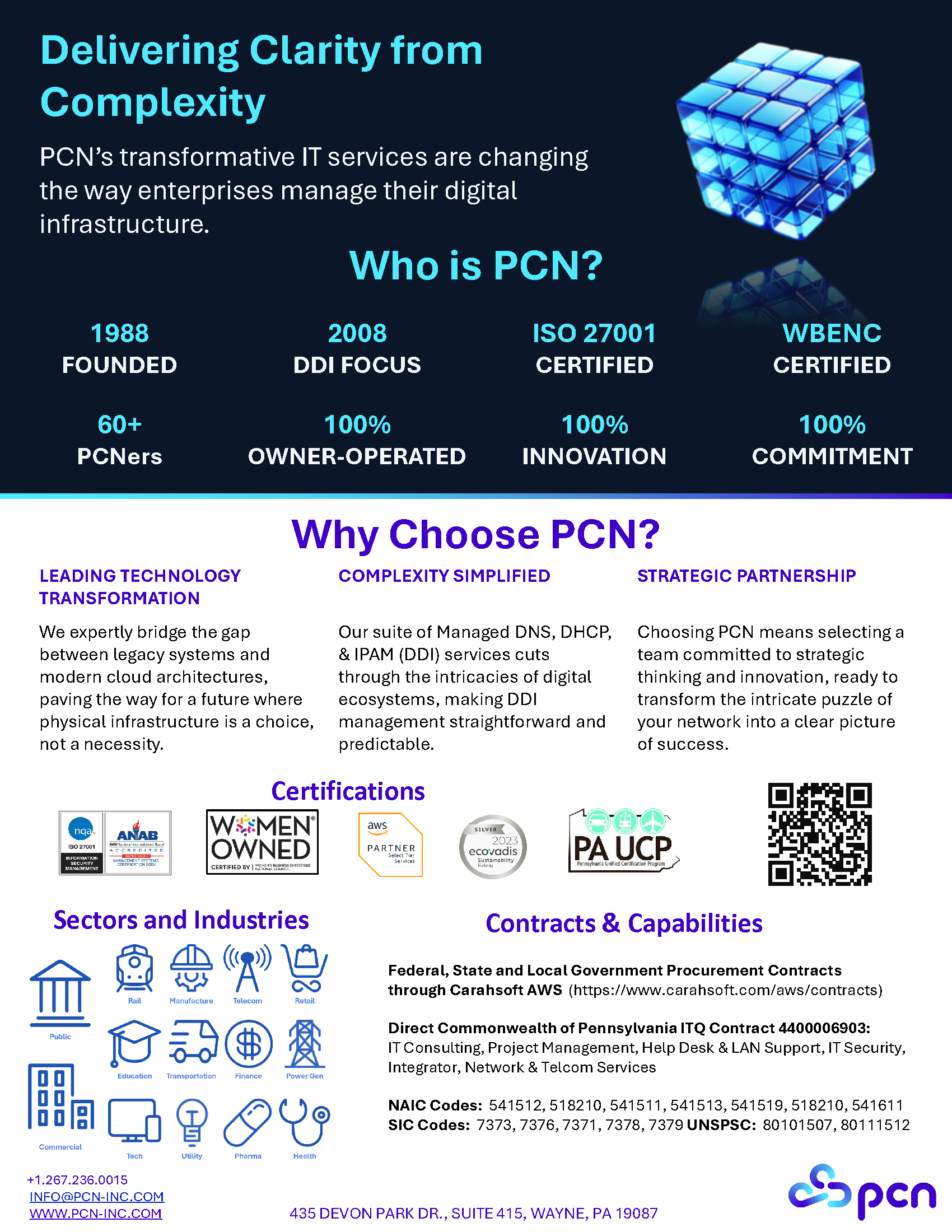
Resources
Delve into our comprehensive resource library, featuring an extensive collection of expert articles and videos, all dedicated to the intricacies and innovations of the DDI industry.
News — Blog — Digital Events — One-Pagers
News
PCN, a leader in tech enabled IT services including Managed DDI (MDDI), DDI as a Service (DDIaaS), Professional Services, Value Added Resale, Service Desk, Security, and Staffing solutions, today announced developments reflecting the company’s commitment to being a True Partner in Change.
PCN is pleased to announce that we have achieved Amazon Web Services (AWS) Select Tier Services Partner status within the AWS Partner Network (APN).
PCN, a recognized global leader in Managed DNS, DHCP, and IPAM (MDDI) and DDI as a Service (DDIaaS), has named Howard Belger Vice President of Strategic Business Development.
PCN’s President & CEO, Katrin Hillner and Dr. Bruce Young, PCN’s GRC Practice Lead, recently met with master’s students from Carnegie Mellon University to support research into the state of cybersecurity risk for education institutions.
Katrin Hillner, PCN’s President & CEO, hosted an interactive WBE Water Cooler event for over thirty women owned businesses
Harrisburg University’s Government Technology Institute’s (GTI) Security Center of Excellence (SCE) in cooperation with PHEAA and the Commonwealth of Pennsylvania hosted its fifth consecutive Privacy Day Event
PCN is pleased to renew our partner membership in GTI and to become a first time partner member of SCE.
PCN’s President & CEO Katrin Hillner is honored to be showcased in Main Line Today’s October Power Woman 2020 issue.
PC Network Inc. (PCN), a customer focused technology and infrastructure service company, is excited to join market leading Infoblox’s Managed Services Partner Program.
PC Network Inc. (PCN), a global technology infrastructure services provider, announces launch of a Governance, Risk, and Compliance (GRC) Security Services practice.
As the number of cases of Coronavirus (COVID-19) continues to grow in Canada, UK and the United States, everyone needs to take precautions for the safety
PCN and Unisys are excited to extend their participation in the Commonwealth of Pennsylvania’s Diversity, Inclusion and Small Business Opportunity Program’s Mentor Protégée program for a second year.
Together with Chad Firestone from Deloitte and John Alwine from Unisys, Katrin Hillner PCN’s CEO addressed the 2019 IT Executives and IT Managers classes.
Jeanette Yung, Technology Strategy Partner at Deloitte and Kathleen Brunner President of Acumen Analytics joined Katrin Hillner President and CEO of PCN
PC Network Inc. (PCN) is pleased to announce the opening of our new headquarters in Wayne, PA.
On June 11, PCN’s President & CEO, Katrin Hillner, was invited to do a Facebook Live Stream with ABC 27 News to discuss the 2019 Women in Technology Gala Event
On June 3, The Technology Council of Central Pennsylvania (TCCP) held its annual Women in Technology Awards Gala at Spring Gate Winery in Harrisburg, PA.
Blog
As IPv6 Day approaches (June 6th), we can take the opportunity to reflect on the critical role that IPv6 plays in keeping us all connected on the internet, and how IP Address Management (IPAM) tools have become even more fundamental to running a successful network
The PCN logo unveiled today is the third in our company’s history. With all the changes in the technology we manage, the business we have built, and the customers we serve, it is time for a change.
Charlotte Veazie, PCN General Counsel, and Brian Thompson, Unisys IAM Advisor, spoke about “Protecting Data Privacy Using Technologies Like Identity Access Management (IAM)” at Harrisburg University’s Data Privacy Day educational summit on January 25, 2024.
The way enterprises, applications on the network, and endpoints are working is changing significantly.
Verizon’s 119 page 2020 Data Breach Investigations Report (DBIR) provides a comprehensive analysis of breaches and incidents.
Digital Events
Harrisburg University’s Government Technology Institute’s (GTI) Security Center of Excellence (SCE) in cooperation with PHEAA and the Commonwealth of Pennsylvania hosted its fifth consecutive Privacy Day Event on Friday January 28th, 2022.
PCN’s James Nutt and David Champagne participate in Infoblox’s ‘Network Discovery & Automation for Hybrid Cloud Transformation’ panel.
PCN’s President & CEO, Katrin Hillner, participates in Harrisburg University’s ‘Panic with Friends’ panel.
PCN’s James Nutt participates in Infoblox’s ‘Remote Worker Security for Corporate Pandemic Survival’ webinar as panel speaker.







































